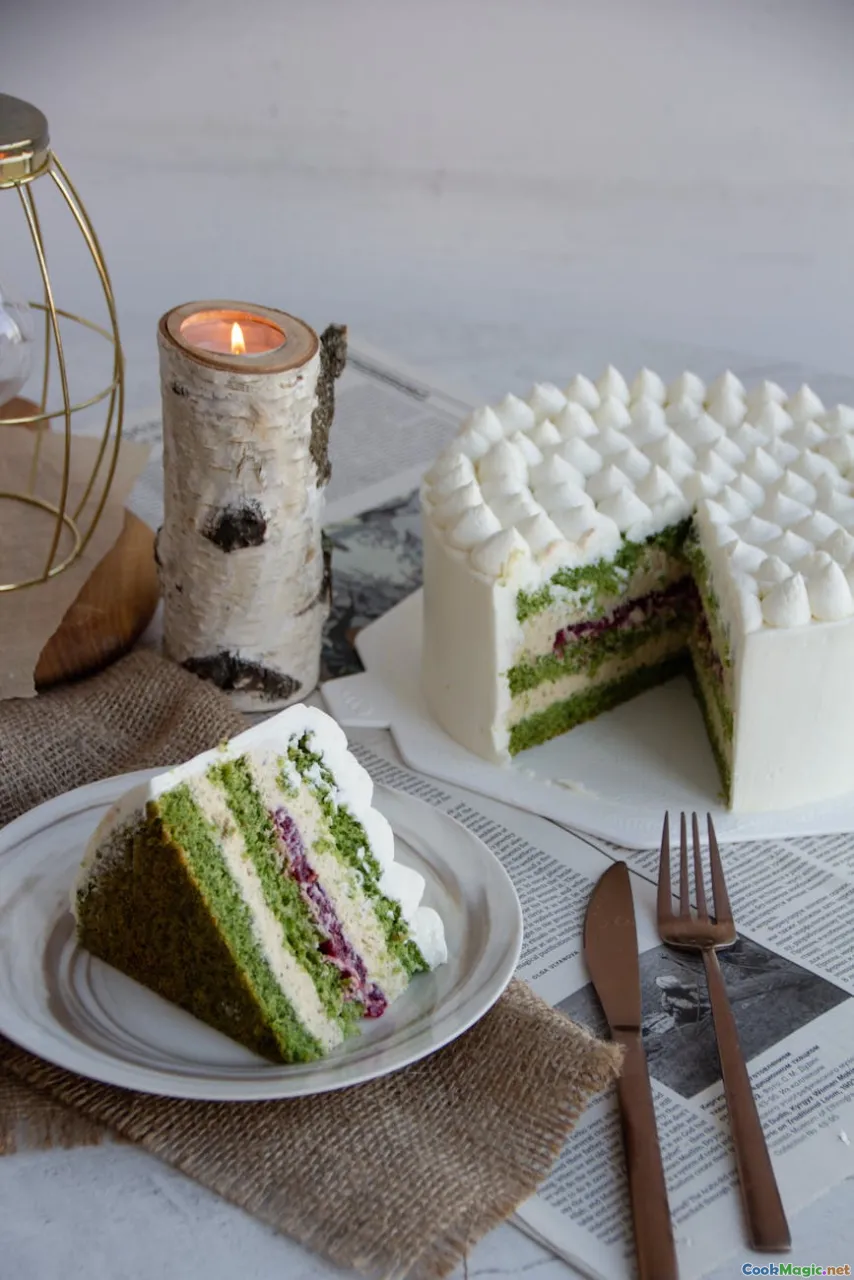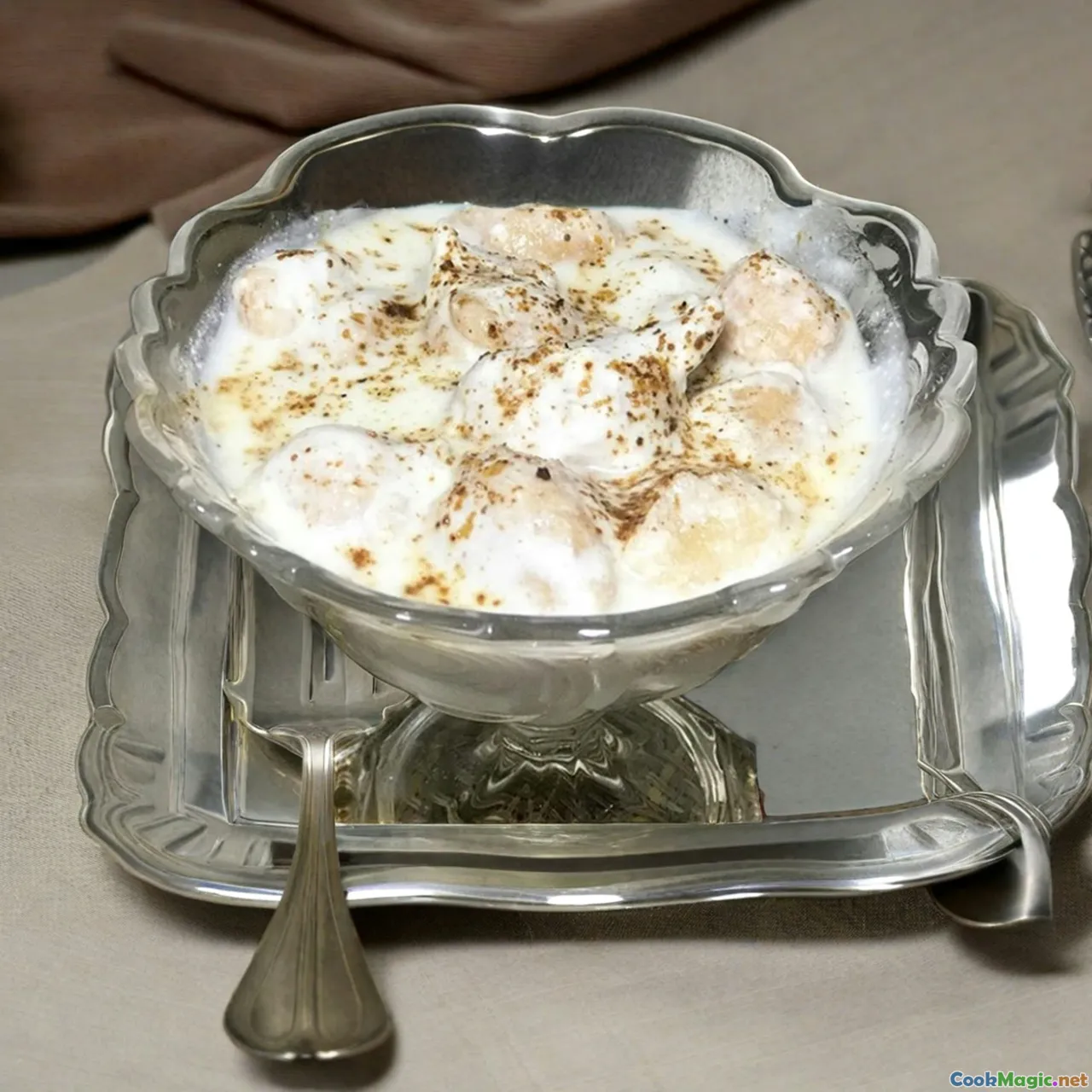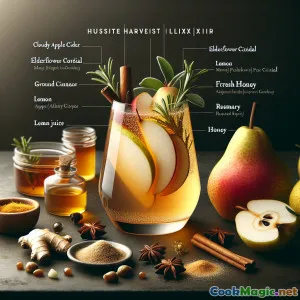
白桦树汁与大麦奶油锅:英国的美味享受
(Birch Sap & Barley Cream Pots: An English Delight)
(0 评论)食材
营养
- 份量: 4
- 每份大小: 1个烤盅(150毫升)
- Calories: 350 kcal
- Carbohydrates: 33 g
- Protein: 7 g
- Fat: 21 g
- Fiber: 2.5 g
- Sugar: 13 g
- Sodium: 70 mg
- Cholesterol: 134 mg
- Calcium: 115 mg
- Iron: 1.2 mg
制作步骤
-
1 - 用牛奶煮大麦:
冲洗珍珠大麦,加入一个小锅中,加入全脂牛奶。用小火慢煮,开盖煮至大麦非常软烂,大约25分钟。经常搅拌以防粘底。稍微放凉备用。
-
2 - 搅拌至奶油般:
将煮熟的大麦和剩余的牛奶倒入搅拌机中。充分搅拌,直到混合物尽可能光滑。用细筛过滤,去除残留的大麦壳,以获得更丝滑的质地。
-
3 - 浸泡桦树汁和奶油:
在一个干净的平底锅中,加入桦树汁、双层奶油、过滤后的大麦混合物以及香草荚的种子(如果使用的话)。轻轻加热,不断搅拌,直到开始冒蒸汽但不沸腾。
-
4 - 准备蛋黄和糖:
同时,用大碗将蛋黄与细砂糖和海盐搅打,直到颜色变得更浅且略微变稠。
-
5 - 调味并混合:
一边不断搅拌,一边缓慢倒入大约三分之一的热桦木大麦奶油到蛋液中。温度调和后,将蛋液倒回锅中,加入剩余的热液体,继续搅拌。
-
6 - 煮制蛋奶酱底:
用小火,不断搅拌混合的蛋奶酱,直到它变得足够浓稠,能覆盖刮刀(如果用温度计,大约82°C)。不要让它煮沸。
-
7 - 放入烤碟冷藏:
将混合物分成四个150毫升的烤碟。冷却至室温,然后盖上盖子,放入冰箱冷藏至少2小时,直到轻微凝固。
-
8 - 装饰与上菜:
上桌时,淋上一点英式蜂蜜,并撒上碎烤榛子(如有需要)。冷藏后享用,口感浓郁顺滑。
冲洗珍珠大麦,加入一个小锅中,加入全脂牛奶。用小火慢煮,开盖煮至大麦非常软烂,大约25分钟。经常搅拌以防粘底。稍微放凉备用。
将煮熟的大麦和剩余的牛奶倒入搅拌机中。充分搅拌,直到混合物尽可能光滑。用细筛过滤,去除残留的大麦壳,以获得更丝滑的质地。
在一个干净的平底锅中,加入桦树汁、双层奶油、过滤后的大麦混合物以及香草荚的种子(如果使用的话)。轻轻加热,不断搅拌,直到开始冒蒸汽但不沸腾。
同时,用大碗将蛋黄与细砂糖和海盐搅打,直到颜色变得更浅且略微变稠。
一边不断搅拌,一边缓慢倒入大约三分之一的热桦木大麦奶油到蛋液中。温度调和后,将蛋液倒回锅中,加入剩余的热液体,继续搅拌。
用小火,不断搅拌混合的蛋奶酱,直到它变得足够浓稠,能覆盖刮刀(如果用温度计,大约82°C)。不要让它煮沸。
将混合物分成四个150毫升的烤碟。冷却至室温,然后盖上盖子,放入冰箱冷藏至少2小时,直到轻微凝固。
上桌时,淋上一点英式蜂蜜,并撒上碎烤榛子(如有需要)。冷藏后享用,口感浓郁顺滑。
关于 白桦树汁与大麦奶油锅:英国的美味享受 :的更多信息
Birch Sap and Barley Cream Pots
Summary
This wholly original recipe for Birch Sap and Barley Cream Pots captures the gentle awakening of an English spring in a delicate, creamy dessert bowl. Combining the subtle, natural sweetness of birch sap with the nutty, old-world flavors of barley, and elevating it all with rich dairy and softly set custard, this dish blurs the lines between modern British innovation and age-old traditions. Its unassuming, creamy aesthetics hint at something more interesting upon first spoonful—an earthy complexity and layers of silky, gentle sweetness.
History and Cultural Significance
Birch sap, gathered from centuries-old woodland traditions, was once a celebrated ingredient in the Northern Hemisphere—tapped for just a few short weeks each spring. In the UK, though largely forgotten in mainstream cuisine, folklore remembers birch sap as a rejuvenating 'British tonic,' sometimes fermented into wine or mixed into healing concoctions. Barley’s role as a staple cereal can be traced from Neolithic times to roots in rustic British desserts and hearty stews, symbolizing resilience, comfort, and an affinity with the landscape.
Combining birch sap with barley in a creamy custard was inspired by traditional milk puddings and contemporary farmhouse desserts, but here given a new voice—bridging foraged, historic flavors and classic dessert typology.
Unique Aspects and Personal Notes
Birch Sap and Barley Cream Pots stand out not just for their writeup of “wild sophistication:”
-
The birch sap brings unique complexity, lightly floral, slightly sweet, unlike anything sugar or syrup could impart. Using birch sap as a base (where you might otherwise reach for milk, water, or coconut water) coaxes out woodsy, sappy nuances and gently perfumes the dessert.
-
Barley lends nutty undertones and provides a textural base for the custard when rendered ultra-smooth. It bulks the cream without heaviness, forming the bridge between tradition and elegance.
-
The slow, low cook and careful tempering of egg yolks ensure an unctuous, gentle set—not quite a thick jelly, more opulent than most milk puddings, yet firmer than classic pouring custard.
-
Lightly sweetened, with a dash of honey to serve, it needs little embellishment: a contrast of roughly chopped hazelnuts highlights the woodland origins and counters the creaminess, while a use of vanilla is purely optional—leaning into (or away from) the pure birch-milk aroma as you wish.
Tips & Notes
- Sourcing birch sap can be the main barrier; look for it bottled online or at specialty food stores during spring. If unavailable, slightly diluted maple water or even coconut water makes a gentle and neutral substitute, though each lacks pure birch nuance.
- The barley cream achieves true silkiness by thorough blending and straining—don’t rush this part.
- If desired, infuse other seasonal wild herbs (like meadowsweet or elderflower) into the cream just before straining, amplifying the wild character of the dessert.
- Keeping the yolk-cream mixture below boiling (82°C/180°F) prevents curdling, giving that opulent texture prized in classic pots de crème.
- These set softly for an impressive table finish but keep hands-off when cooling; the chilling step is essential to their success.
Variations and Serving
You may experiment with nut toppings—try toasted pecans or almonds. Birch syrup (used with restraint) works as a garnish for darker caramel bitterness, or swap in seasonal berries and a little buttermilk for a tart contrast. Best served foraged-ingredient dinners, a woodland afternoon tea, or simply to evoke lush English meadows wherever you are. If serving to guests, the story of birch sap’s scarcity and tradition could become the star conversation.
This unique dessert pot manages to be both subtly wild and beautifully refined—an unmistakable taste of the British landscape, reimagined for today’s palate.
























